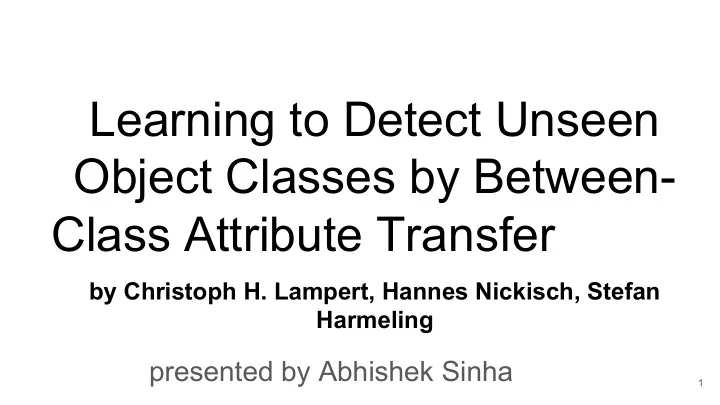

Learning to Detect Unseen Object Classes by Between- Class Attribute Transfer by Christoph H. Lampert, Hannes Nickisch, Stefan Harmeling presented by Abhishek Sinha 1
Problem Definition Lampert, Nickisch et. al. 2
Problem Definition (Continued) Lampert, Nickisch et. al. 3
Algorithm 4
Flat Classification Lampert, Nickisch et. al. 5
DAP Lampert, Nickisch et. al. 6
IAP Lampert, Nickisch et. al. 7
Experiments 8
Outline ● Intermediate Layer Representations ● Impact of overlap among training and test classes ● Impact of correlation among attributes ● Results on a new dataset - SUN Attribute Database 9
Intermediate Layer Representations 10
Setup ● Took the same training/test split as the paper ● Visualized the intermediate representations generated by IAP ○ HeatMap of test classes vs training classes to visualize the training class layer ○ HeatMap of test classes vs attributes to visualize the attribute layer. 11
Original Confusion Matrix Lampert, Nickisch et. al. 12
IAP Training Class Layer 13
IAP Training Class Layer 14
IAP Training Class Layer 15
IAP Attribute Layer 16
IAP Attribute Layer 17
Conclusions ● Classes with high accuracy get mapped to similar training classes ● Classes with low accuracy do not get mapped to similar training classes ○ There aren’t similar enough classes ○ There are pretty similar classes but the algorithm doesn’t discover them ● Classes with high accuracy have good attribute representation ○ At least, one or a couple of attributes are discriminative enough and the class has a high score on it. ● Attributes with lower accuracy either have ○ low score for relevant discriminating attribute ○ poor attribute representation - all attributes with high score are too general. 18
Overlapping Test and Train Classes 19
Setup ● Took 40 training and 19 test classes with 9 overlapping classes ○ deer, bobcat, lion, mouse, polar+bear, collie, walrus, cow, dolphin ● Used the same feature space as the paper ● Visualized the training class layer representation, attribute layer representation and confusion matrix ● Overall test class accuracy decreased from 27.4% to 26.5% 20
Final Confusion Matrix 21
Final Confusion Matrix 22
Final Confusion Matrix 23
IAP Training Classes Layer 24
IAP Attribute Layer 25
IAP Attribute Layer 26
Conclusions ● Overlapping classes get correctly mapped at the training class layer ● But attribute representation in this case ambiguates the situation ○ Loss of Information ○ The final test class ends up being wrong ● Overlapping classes are not easy instances for IAP if there exist other similar test classes 27
Impact of Correlation 28
Setup ● First plotted the 85 x 85 distance matrix where each entry is the cosine distance between the corresponding attributes. ○ Attributes are represented as class vectors (containing a score for each class in the dataset). ● Clustered the attributes using the above cosine distance metric. ○ Each cluster can be looked at as a Super Attribute ● Computed the variation of final test class accuracy with number of clusters 29
Correlation Among Attributes 30
Accuracy vs Number of Clusters Test Class Accuracy(Best) 31 Number of Clusters
Confusion Matrix for Best Case - Worse Off Classes Lampert, Nickisch et. al. 32
Confusion Matrix for Best Case - Same Classes Lampert, Nickisch et. al. 33
Confusion Matrix for Best Case - Better Classes Lampert, Nickisch et. al. 34
Examples of Super Attributes 'brown', 'furry', 'lean', 'tail', 'chewteeth', 'walks', 'fast', 'muscle', 'quadrapedal', 'active', 'agility', 'newworld', 'oldworld', 'ground', 'smart', 'nestspot' wikipedia wikipedia 35
Conclusion ● For classes that were pretty ‘close’, clustering actually leads to decrease in the accuracy. ○ e.g. Persian Cat and Leopard were earlier identified correctly but now both get mapped to leopard. ● For many other classes, clustering helps in removing noise and avoid accidental similarities. ○ e.g. Rat initially had high score along ‘paws’, ‘claws’ which was probably why it was getting mapped to leopard ○ After clustering, it will no longer get mapped to the super attribute containing [ ‘paws’,’claws’] since the super attribute also contains many other attributes not relevant to it. ○ More likely to get mapped to the super attribute containing [‘brown’, ‘furry’,’tail’,’chewteeth’,’ agility’] which makes it easier to identify. 36
SUN Attribute Database 37
Description of Database 1 and Experiment ● Around 14000 images of 600 odd scene categories. ○ Categories such as airport, jail, kitchen, waterfall etc. ● 102 scene attributes ○ Attributes describe what objects those scenes contain as well as the activities performed ○ Attributes include biking, hiking, studying, trees etc. ● Split the 600 odd classes into 550 randomly chosen train classes and around 60 test classes ● Attained only 4.7% accuracy on the test classes https://cs.brown.edu/~gen/sunattributes.html 38
Results 39
Conclusion ● Results are much worse than on the Animals with Attribute dataset ● One of the reasons is number of training samples per class ○ Animals with Attributes - 30,000 images for 50 classes ○ SUN Attribute DB - 14000 images for around 600 classes ● Predicate Matrix is sparser for the SUN Attribute DB case ● Possibly easier to specify discriminating attributes for animals than scenes ● IAP has a tendency to output only a small percentage of all test classes ○ In the original paper, 5 of the 10 test classes have zero weight ○ This tendency might be getting magnified because of the sparseness in the data 40
Questions 41
Recommend
More recommend